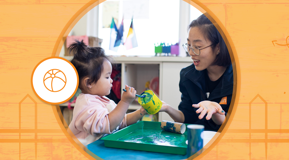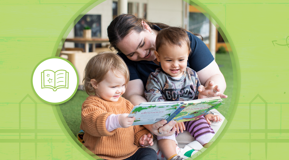Communication in autistic children

Before you read
In this article, we share general information about some areas of development and the differences that might be seen in autistic children.
Every child with autism is unique and different. While they may share some similar traits, it’s important to know that each child will have their own learning styles, interests and preferences.
This information is designed to help you understand and support your autistic child. Always speak to their therapist/s before introducing any new strategies in the home.
Some of the strategies might be helpful for children without autism or without a diagnosis. We recommend speaking with your child’s early learning centre, your GP and/or your family network for more support.
What is communication?
Communication is the exchange of thoughts, opinions, feelings or information. Communication happens when people send and receive messages in different ways. People can communicate verbally with words or nonverbally with facial expressions, gestures and other body movements.
How do autistic children communicate?
Communication is just as important for autistic children as it is for everyone else. However, autistic children often find communication difficult because of their learning styles and sensory preferences.
Your child may communicate in some of the following ways:
-
Pointing at what they want.
-
Reaching out for an object.
-
Using facial expressions.
-
Crying or shouting.
-
Moving towards what they like.
-
Taking your hand to what they want.
-
Looking at what they want.
-
Using pictures.
-
Making sounds.
-
Using words and/or sentences.
-
Using echolalia*.
*Echolalia is the repetition of words or phrases, either immediately after hearing them or at a later time. Some children with autism use echolalia as a form of communication, either to express themselves or as a way of processing language.
Pre-intentional & intentional communication
Your child can communicate pre-intentionally or intentionally for a range of purposes.
Pre-intentional communication is when your child sends you a message without meaning to. You might interpret their actions as if they were communicating directly to you. They might be trying to calm themselves, practice something, show that they enjoy something, reach for something they want, protest or refuse.
Intentional communication is when your child sends a message on purpose. It can usually be easily understood. They might communicate intentionally for different reasons:
-
To protest, refuse or ask for something.
-
For social reasons, such as greeting someone.
-
To find out about something (asking questions).
-
To talk about an idea, opinion or event.
-
To express their feelings.
-
To make connections and build relationships.
What can families do to help?
There are lots of ways you can support your child to communicate with you, and their language development. Here are a few ideas:
-
Follow your child’s interests — all children are more engaged when they are interested in something.
-
Use single words or short sentences to talk about what you’re doing, or what your child is doing, e.g. “Shoes on.”, “Car!”.
-
Expand on your child’s single words to longer sentences, e.g. “Water" to “Drink water.”
-
Give your child an opportunity to communicate with you, e.g. offer them choices - "Blue shirt or green shirt?", "Car or train?"
-
Give your child time to respond.
-
Use playful tones and varied pitch to make talking fun!
Summary
-
Communication can be verbal or non-verbal – and is the way we share ideas, thoughts, feelings and information.
-
All children communicate, and autistic children communicate depending on their learning style and sensory preferences – they may use pointing, reaching, echolalia, pictures, or even movement to express their needs and feelings.
-
Pre-intentional vs. intentional communication – some actions may not be purposeful but still convey a message. Other times, a child deliberately communicates to ask, refuse, connect, or express emotions.
-
Families can support their child's communication in different ways – such as encouraging interaction through interests, short sentences, expanding language, offering choices, using playful tones and giving time to respond.









